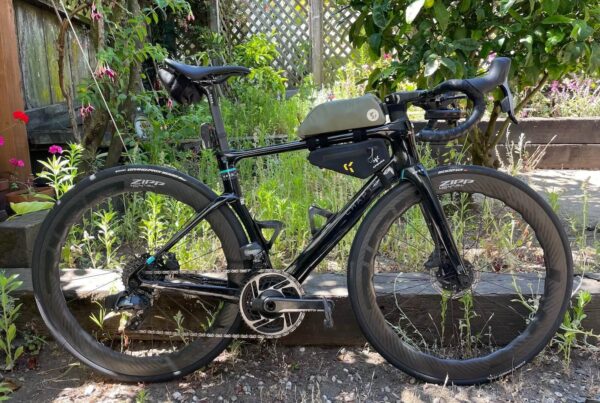The year was 1982. Argentina and the United Kingdom went to war over some South Atlantic islands with a combined population of some 3000 Britons and half a million sheep. The Commodore 64 was the big news in personal computers. New Order was in the studio recording what would become the biggest selling 12” of all time. And the Idaho state legislature was revising its traffic code.
At that time, minor traffic offenses in Idaho were criminal offenses; the legislative revision was a streamlining program aimed at reducing most of these minor offenses from misdemeanors to “civil public offenses.”
Carl Bianchi was a cyclist; he was also the Administrative Director of the Courts in Idaho, and would later serve as the first Director of Legislative Services for the Idaho State legislature. In his professional capacity, Bianchi had been approached by magistrates with complaints that law enforcement was ticketing cyclists for failure to come to a complete, foot-down stop. Magistrates considered these technical violations to be functional and common cycling behavior, but under the law, they had no option but to fine cyclists for these violations. Bianchi and the magistrates who were bringing these concerns to him felt that these “technical violations” were unnecessarily cluttering the courts.
In each of the two previous years, bills to modernize the state’s bicycle laws had been introduced and failed. When the legislature initiated its revision of the state’s traffic code, Bianchi saw an opportunity to attach a modernized bicycle law onto the larger revision of the traffic code; with the assistance of cyclists and judicial officials, Bianchi agreed to draft a new bicycle code.
Bianchi’s draft brought the bicycle code into close conformity with the Uniform Vehicle Code, with new provisions allowing cyclists to take the lane, or to merge left, when appropriate. Addressing the concerns of the state’s magistrates, the draft also contained a provision that allowed cyclists to treat a stop sign as a yield sign—the so-called “rolling stop law.”
Although the draft law was an improvement over the existing law, Carl Bianchi wrote then that the provision allowing rolling stops was quietly opposed by the League of American Bicyclists (known then as the League of American Wheelmen), but did not want to raise the issue in the legislature. According to Bianchi, Pat Riceci, the League’s Legislative Representative for the state, explained:
I was looking at ten things that I liked and one that I didn’t. We all have hidden agendas. I wanted that position on the roadway wording real bad, and I was willing to bend elsewhere to get it.
The danger the League faced was that opposing the rolling stop provision in the legislature would invite closer scrutiny and debate of the bicycle law’s other provisions. “Besides,” Riceci explained at the time,
[NOTE: I recently discussed the passage of the Idaho legislation with Riceci via email. He does not recall having been the League’s state legislative representative at that time, nor does he recall being opposed, either actively or passively, to the legislation—in fact, as he recalls, it was “just the opposite.” Regardess of whether or not the reports at that time were correct, it is clear that there was at least some difference of opinion within the League, with John Allen and League vice president John Forester in support of the legislation, and National Legislative Director Ralph Hirsch, and possibly Pat Riceci, expressing their misgivings.]I’m not adamantly opposed to the rolling stop law. I’m willing to compromise and see if it works.
The revised bicycle law was included in the larger bill revising the traffic code, and this time, was passed by the legislature. Although Riceci was willing to give the new law a try, he nevertheless felt that cycling advocates should not “be asking for more than autos are given.” Former rolling stop supporter Jack Gillette, then-President of the Boise Bicycle Commuters Association, agreed with that position, arguing that “Bicyclists want the same rights as drivers, and maybe they should have the same duties.”
The League’s state representative was not alone in expressing doubts about the rolling stop law; law enforcement officers were concerned about the wisdom of allowing children to roll through intersections. Idaho State Police Sgt. Doug Kramer asked
If we don’t let people drive cars until they are 16, and then still don’t let them use their judgment at an intersection, how can we let a small child exercise that judgment at an intersection?
The problem, Boise Police Sgt. Doug Kraemer noted, is that “You can’t design laws for the skilled minority.” Addressing that same concern, former rolling stop supporter Jack Gillette observed
We have to make laws for the lowest common denominator, and the lowest common denominator is still a kid.
Taking the opposite point of view, Eric Guise, the former Ada County Bicycle Coordinator, argued that
The basic philosophy should be to design the laws for the most competent rider or commuter. Bicycle codes should be designed to allow bicycles to travel within the city more swiftly and easily, so that bikes can play a significant role in the transportation system.
Conservation of energy is paramount to moving about on a bike. Overcoming inertia is the key. Bikers try to keep moving, and increasing the number of stops makes it harder for a rider to progress. Most riders do not now stop.
Countering that perspective, John Williams, editor-in-chief of Bicycling Forum magazine argued that
The “momentum” argument is garbage. If the stop signs are located for good reasons (not always the case), then conservation of momentum should take a back seat to other considerations. If the stop signs were not located for good reasons, then cyclists and motorists should unite to get them removed.
A different problem with the new law was raised by Ralph Hirsch, then National Legislative Director for the League: The new law lacked a “presumption of fault” clause. This clause, present in the Uniform Vehicle Code’s treatment of yield signs, specified that if a motorist drives past a yield sign, and is involved in a collision in the intersection, “such collision shall be prima facie evidence of his failure to yield the right of way.” This means that it is presumed that the motorist failed to yield the right of way, but the motorist can rebut that presumption with the introduction of contradictory evidence. Because the new “stop as yield” law in Idaho did not contain a “presumption of fault” clause, Hirsch argued that determinations of fault would be more difficult to establish.
By then, the law had been passed, and as debate still raged as to whether or not it was a good idea, both sides wondered if it would survive the year.
It did, and then some…
Postscript
By 2005, Idaho’s “stop as yield” law had been on the books for twenty-two years. It had only undergone one revision, in 1988, when a provision authorizing bicycle safety education programs was eliminated from the codified statute.
In 2005, a new issue came to the fore. As originally written, the law allowed cyclists to roll through red lights if they were making a right turn, or a left turn onto a one-way highway; Idaho law enforcement officials felt that the law needed to be clarified in regards to a cyclist’s duties when proceeding straight or turning left through an intersection controlled by a red light. The Idaho legislature agreed with law enforcement, amending the statute to specify that cyclists must stop on red and yield before proceeding straight through the intersection, and before turning left at an intersection. The revision took effect in 2006.
Aside from those two minor revisions, the law has remained in effect for a quarter of a century now. Today, following on the heels of Idaho’s quarter century of experience with allowing cyclists to treat stop signs as yield signs, other states are considering adopting an Idaho-style “stop as yield” law. In the next article in this series, we’ll begin to examine this growing momentum.
For previous articles in this series, see:
Braking Story- The Idaho “Stop As Yield” Law (January 25, 2009)
Legally Speaking- Stop As Yield (January 22, 2009)
For further reading on the passage of the Idaho “stop as yield” law, see Bianchi, Carl, “Controversy in the Great Potato,” Bicycling, 192 (March, 1983).




“Idaho law enforcement officials felt that the law needed to be clarified in regards to a cyclists duties when proceeding straight or turning left through an intersection controlled by a red light. The Idaho legislature agreed with law enforcement, amending the statute to specify that cyclists must stop on red and yield before proceeding straight through the intersection, and before turning left at an intersection.”
I can only imagine how irritating that must be for drivers who are waiting for the light to change. I can understand that for intersections with four-way stop signs this may be a good law to enact, and would be good for motorists as well. But for intersections with stop lights…I imagine that these are usually busier thoroughfares and exceptional judgment along with a high degree of skill are required to enter and exit the intersection.
It’s very interesting that many in the bicycling community opposed the law. Personally, I think making the law conform to practice where it has been shown to be safe makes sense.
Certainly there are benefits. I am simply skeptical of a blanket application for all intersections. For example, some intersections have a No Left Turn or No Right Turn for motor vehicles, but apply an exception for people riding bicycles. This is not the law for all intersections, as many are deemed simply too hazardous. This exception has been designed after many thorough examinations of the specific dynamics of the intersection.
In addition, the reality that I’m concerned about is two-fold – 1) that the law makes it enticing for less skilled individuals to attempt to “make it across” and end up in a collision and, 2) if such an accident does occur, who is at fault? Obviously in a standard intersection, should a motor vehicle go through a red light, hitting someone who advancing on green, the law is clear. But what happens if a cyclist is hit in the intersection?
Wow, how interesting that a guy with the name Bianchi helped get this law into the books.
As far as the skepticism, the law has been on the books for many years. The statistics I’ve heard is that the bicycle incidents haven’t increased at all. Maybe we will get more information on this on the next entry.
I’m completely in favor of this law spreading to other states.
Interesting read.
This law rocks. Especially when you weigh 250+ lbs, as I do. It takes a lot of energy to get me back up to cruising speed.
This law makes it so I can ride nearly as fast as cars drive. When I commute by bike, I take the side road that has stop signs instead of lights. That road is no where near as crowded at the main drag and makes my ride feel substantially safer.
I don’t think people should use the Idaho stop if wearing earphones, of course I don’t think you should ride on the road at all with earphones.
Michael: The red-light deal here means the same as a stop sign for cars. Practically speaking, you only use it when the light is red and there’s no traffic, or towards the end of a cycle (just before your light turns green and there’s no more cross traffic) so you can get just a little jump on the cars. If it’s a busy intersection, you wait for the green just like everyone else. (I try to watch the lights and control my speed so I don’t get to the intersection until the light is green, conservation of energy and all….)
If the purpose of the law is to allow cyclists to coast through when no other vehicle traffic is around, except for a police officer who is watching the intersection, then I get it. I pull my 2 sons in a trailer, and trust me, starting from a full stop with 100 lbs+ in back, along with my own weight is almost enough to convince me that a stop as yield law is extremely helpful in getting me to my destination.
Emergency stopping with a trailer however, is something else all together. And with the law on the side of drivers, the risk outweighs the benefit.
Along with an exponential increase in vehicle traffic, this law quickly becomes moot over the next 10 to 20 years. Improved bicycle infrastructure and protection through new laws would be of greater benefit to me.
@michael: The problem is most Idaho lights are “trip” lights. The only timed lights are in large communities. If you’ve ever tried to get a light to trip on a bike, you can see the diffuculty
Ah, well that sucks! Thank you for the clarification. Then I see the point of the law there.
Thanks for making a research. This is a very interesting post. Well, it seems to me the fact that “minor traffic offenses in Idaho were criminal offenses” is a crazy thing … I wonder if such laws have decreased the number of road accidents.
The rationale I see most frequently is that the rolling stop uses less energy and thus makes cycling more enjoyable. I’m convinced that it makes cycling safer, as we spend less time in the path of approaching vehicles, and we spend less time at slow, unstable speeds. When I need to stop at stop signs, I’m frequently passed by cars that blow by me in the intersection.
I was just ticketed for a rolling stop in a residential area, while making a right turn. I had yielded the right of way to a car before proceeding into the intersection. Got a big lecture from a cop, which really made me mad. I’m commuting, in no big hurry, but I truly believe that a complete stop is more hazardous to a cyclist than this Idaho stop.
I concur with Gary DelNero: in many stop-light situations it is far more dangerous to be accelerating from standstill alongside a phalanx of motor cars. Reducing the time in a junction has also been a big safety factor for me on several occasions. Reducing the speed differential between cars and bikes in junctions is another safety issue Gary points to that I too have experienced. These issues apply to every single cyclist out on the roads.
Good points, Gary!
I agree with Michel Kurita that new laws specifically addressing cyclists, and more dedicated cycle paths, will be of greater benefit to cyclists. But we can never hope to have a network of cycle paths as dense as the road network. Therefore we must continue to apply pressure on the roads.
I would like to add that cyclists should not conform to the prevailing laws. If we do conform, the push-back will be that the laws must work and there is no need to change. Therefore, cyclists across America must continue to break these laws, clog up the courts with our minor traffic infringements, and be sure to articulate our position to the magistrates.
I’m in favor of the “stop as yield” law because it’s safer! A cyclist is most vulnerable, and most likely to veer out of control or to fall (possibly into traffic), when starting and stopping. Watch any cyclist, even a Chris Froome, wobble for his first few cranks to get rolling. A cyclist is even more vulnerable when doing that while surrounded by cars – hence, if the cyclist can get through a red light ahead of motor traffic (assuming no cross traffic), or maintain momentum through a stop sign, it’s safer all around. Plus, a bike is in most ways more maneuverable than a car — takes up less space, and starts and turns quicker — but less able to accelerate quickly. We’re really something in between a pedestrian and a motor vehicle, so we should have laws that take that into account.